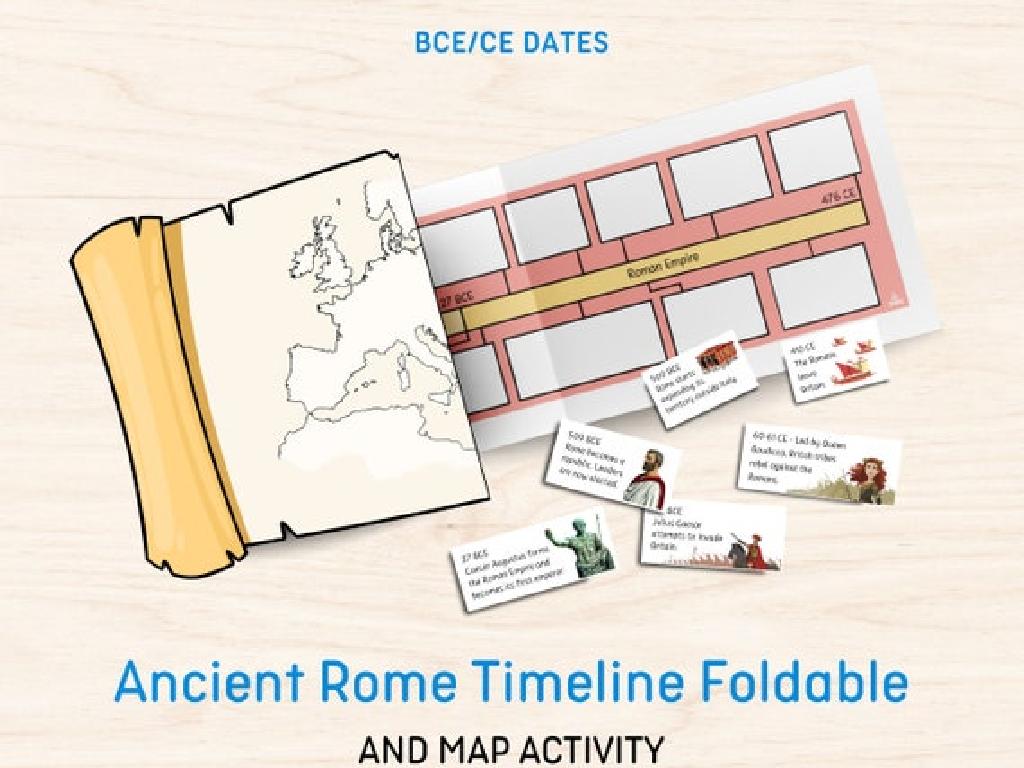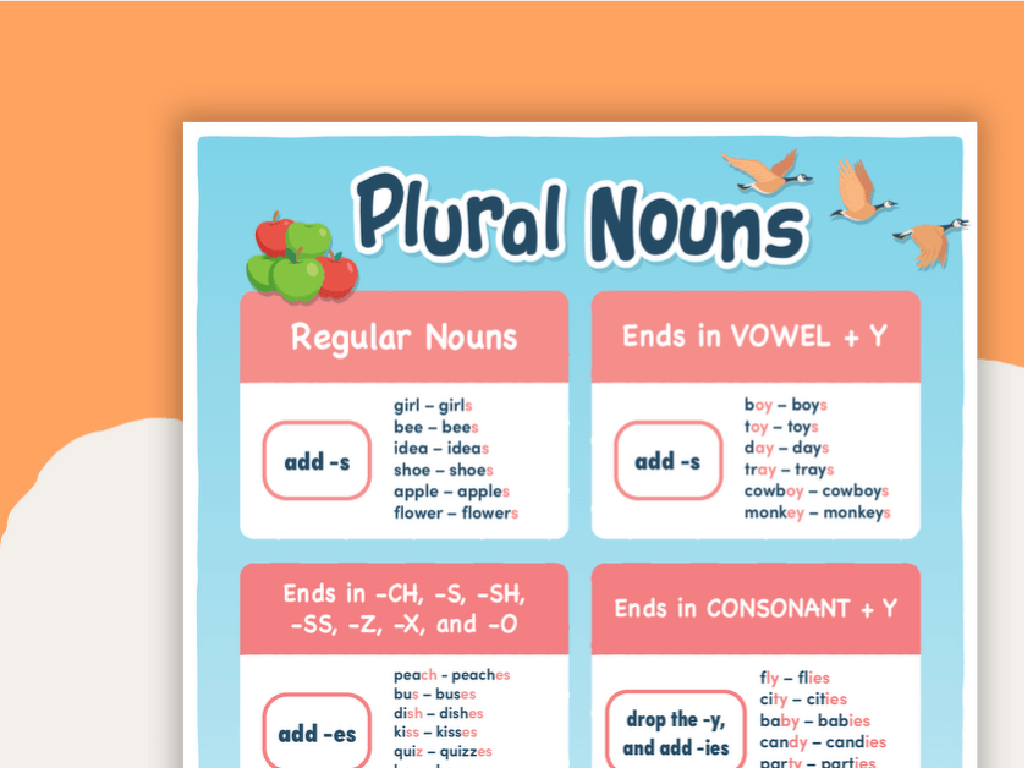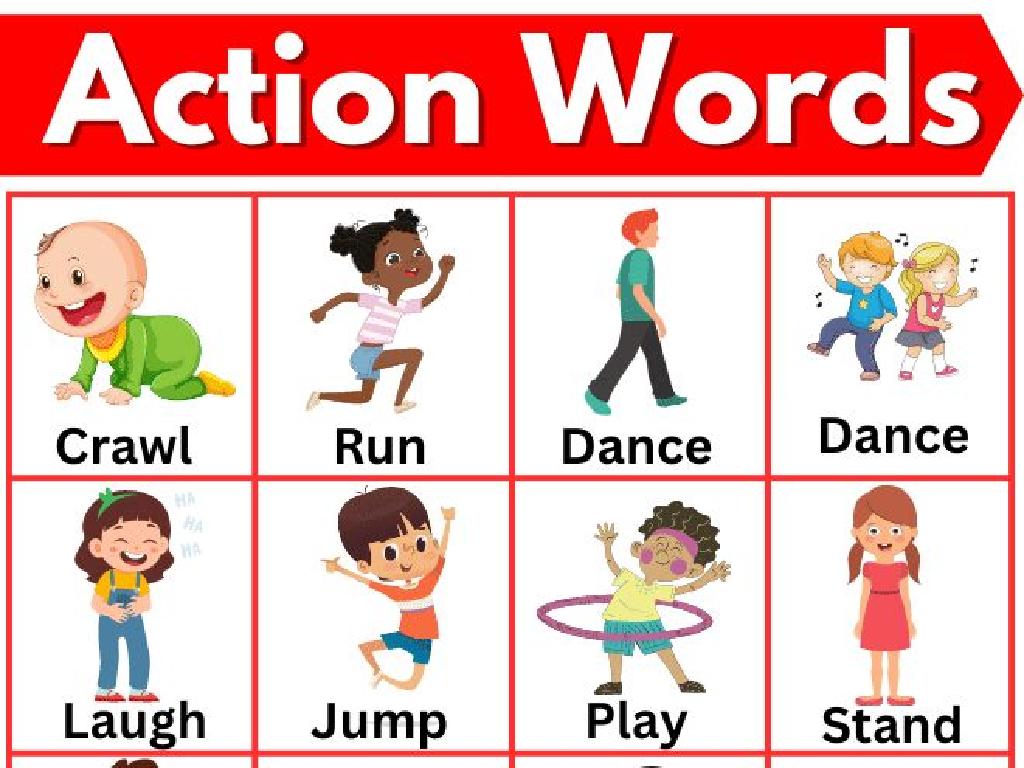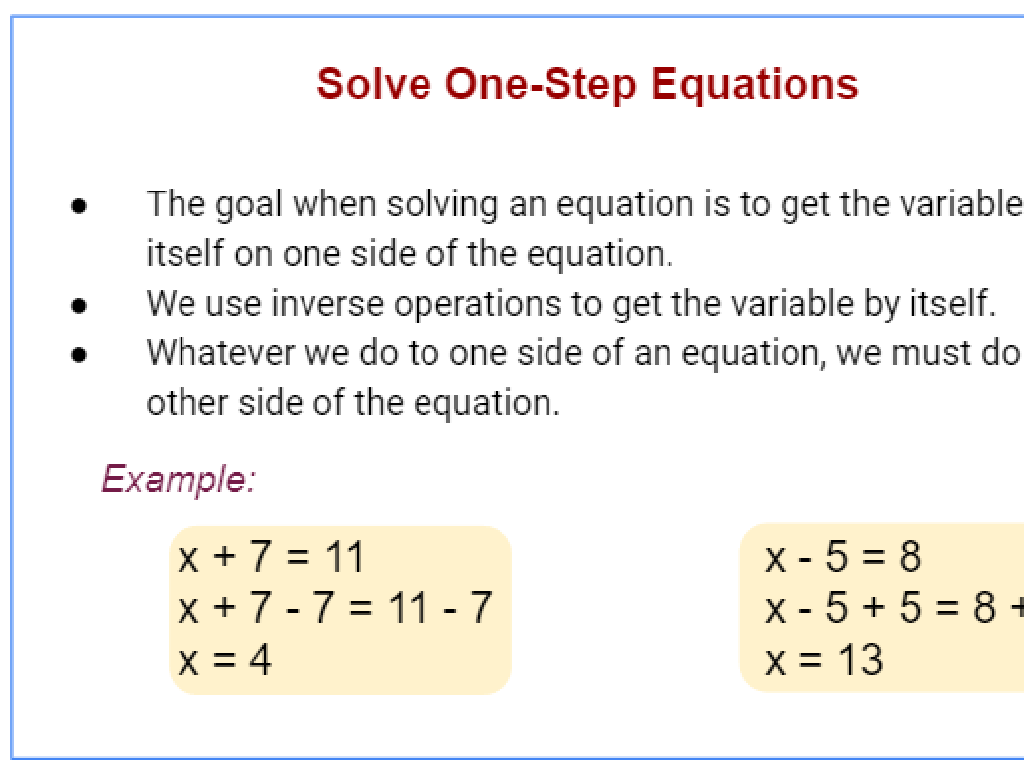Skip-Counting By Fives
Subject: Math
Grade: Second grade
Topic: Skip-Counting And Number Patterns
Please LOG IN to download the presentation. Access is available to registered users only.
View More Content
Welcome to Skip-Counting by Fives!
– Understanding Skip-Counting
– Skip-Counting means jumping over numbers in a pattern.
– Skip-Counting: Hopping Along Numbers
– Imagine hopping over every other step on stairs that’s skip-counting!
– Today’s Adventure: Counting by Fives
– We’ll jump by fives: 5, 10, 15, 20, and so on.
– Practice Makes Perfect
|
This slide introduces the concept of skip-counting, a fundamental skill in early mathematics that helps with understanding number patterns and prepares students for multiplication. Explain skip-counting as moving along the number line in steps larger than one, similar to skipping steps on a staircase. Today’s focus is on counting by fives, which is a practical skill for telling time, counting money, and more. Encourage students to practice by counting objects in groups of five, using their fingers to help keep track, or even clapping and stepping to the rhythm of counting by fives to make the activity engaging and memorable.
Understanding Fives: Skip-Counting
– Counting by ones to five
– Start at 1 and count: 1, 2, 3, 4, 5
– ‘Hops’ in skip-counting
– Every 5th count is a ‘hop’ when we skip-count
– Practice counting together
– Let’s count as a class: 5, 10, 15, 20
– Recognize patterns of five
– Notice how each number ends in 5 or 0
|
This slide introduces the concept of skip-counting by fives to second graders. Begin by counting by ones to five to establish a base understanding. Explain that in skip-counting, every time we reach a number like five, we take a ‘hop’ to the next number in the sequence. Practice as a class by counting out loud together, emphasizing the ‘hops’ at every interval of five. This will help students recognize the pattern that numbers ending in 5 or 0 follow when skip-counting by fives. Encourage students to use their fingers to count and visualize the ‘hops’ as they count.
Skip-Counting by Fives
– Visualize skip-counting on a number line
– See how we jump over numbers to count by fives
– Sequence of fives: 5, 10, 15, 20…
– Understand the pattern: each number is 5 more than the last
– Predict the next numbers in the sequence
– Can you guess what number comes after 20?
– Practice counting by fives as a class
– We’ll count together from 5 to 100 by fives!
|
This slide introduces the concept of skip-counting by fives, which is a fundamental skill in understanding number patterns. Start by showing a number line and demonstrate how to count by fives, emphasizing the ‘skipping’ over other numbers. Highlight the pattern that each subsequent number is 5 more than the previous one. Engage the students by asking them to predict the next numbers in the sequence after 20. Finally, involve the whole class in a counting exercise, starting at 5 and continuing to 100, to reinforce the concept. This activity will help students recognize patterns and build a foundation for multiplication.
Patterns in Skip-Counting by Fives
– Recognizing patterns in numbers
– Ones place: alternating 0 and 5
– Look: 5, 10, 15, 20… See the last digit?
– Exploring patterns on a hundred chart
– Use the chart to see the skip-counting visually
– Practice skip-counting by fives
– Let’s count together: 5, 10, 15, 20…
|
This slide introduces students to the concept of patterns within skip-counting by fives. Emphasize the repetition in the ones place, which makes it easier to predict the next number in the sequence. Using a hundred chart can visually reinforce this concept, as students can see the numbers they skip over and the pattern they create. Encourage the students to practice by counting aloud as a class, and perhaps even have them highlight or circle the numbers on a hundred chart as they go. This will help solidify their understanding of the pattern and the concept of skip-counting by fives.
Counting by Fives with Our Hands
– Each finger is five
– Raise a finger for each five
– Practice counting: 5 to 50
– Start with one hand: 5, 10, 15, 20, 25
– Counting by fives is fun!
– Then use both hands: 30, 35, 40, 45, 50
|
This slide is designed to teach second graders how to skip-count by fives using their hands as visual and tactile aids. Each finger represents the number five, and as they raise a finger, they add five to their count. Begin with one hand to count from 5 to 25, then raise the second hand to continue from 30 to 50. This method makes learning to count by fives interactive and engaging. Encourage the students to practice together in class and at home. The teacher should demonstrate first, then have the students follow along, ensuring they understand that each new number is five more than the last.
Skip-Counting by Fives in Daily Life
– Telling time with skip-counting
– Clocks use numbers in multiples of 5 to show minutes.
– Counting nickels using fives
– Each nickel is worth 5 cents, so we count by fives.
– Daily uses of skip-counting
– We use skip-counting for tasks like tallying scores or items.
– Practice with real examples
|
This slide aims to show students how skip-counting by fives is not just a math exercise, but a useful skill in everyday life. For example, when telling time, the minute hand is counted in increments of five. With money, particularly nickels, we add by fives to find the total value. Skip-counting also helps in situations like keeping score in games or quickly counting items. Encourage students to think of times they have used or could use skip-counting by fives in their lives. Provide them with practical examples to work through, such as figuring out how many minutes until recess if the clock shows it’s 10:10 AM, or how much money they have if they have 4 nickels.
Skip-Counting by Fives Game
– Let’s play a skip-counting game
– Land on a space, say the number
– When you land, shout out ‘5, 10, 15’ and so on!
– Practice counting by fives
– Helps us learn to add five quickly
– Get ready to have fun and learn
|
This interactive game is designed to help second graders practice and reinforce their skip-counting by fives skills. As they move around the game board, they will land on spaces that require them to count aloud by fives. This activity not only makes learning fun but also encourages participation and helps students to memorize the number pattern. For the teacher: Prepare a game board with spaces numbered in multiples of five. You can use a dice to move the students along the board. Have variations ready for different skill levels, such as starting from numbers other than zero, or counting backwards. Encourage students to listen to each other, correct mistakes, and cheer their peers on. This will create a supportive learning environment.
Class Activity: Counting by Fives Relay
– Form teams and line up
– Count by fives before passing the ‘baton’
– Start with 5, 10, 15, and so on
– Race to count to 100 by fives
– Winning team celebrates!
|
This activity is designed to make learning skip-counting by fives interactive and fun. Divide the class into small teams and have them line up. Give the first student in each line a ‘baton’ to pass after they count by fives. The next student continues the sequence. The goal is to reach 100 by counting in increments of five. The first team to do so wins the relay. This exercise helps reinforce number patterns and encourages teamwork. Possible variations include counting by fives from different starting points, using a timer to challenge teams, or having students write down the sequence on a board as they count.
Conclusion: Skip-Counting by Fives
– Recap of skip-counting by fives
– We learned to count by 5s: 5, 10, 15, 20, and so on.
– Importance of counting by fives
– It helps in quick calculations & understanding patterns.
– Counting by fives from any number
– Let’s try: starting from 7, we go 12, 17, 22, 27…
– Practice makes perfect
|
In this concluding slide, we review the concept of skip-counting by fives, emphasizing its importance in everyday calculations such as telling time and making quick estimates. We also encourage students to demonstrate their understanding by skip-counting from non-traditional starting points, which reinforces the concept and shows its versatility. The slide aims to consolidate the lesson’s learning objectives and prepare students for practical applications of skip-counting. Teachers should prompt students to practice skip-counting by fives with various starting numbers to ensure they grasp the pattern and can apply it confidently.






